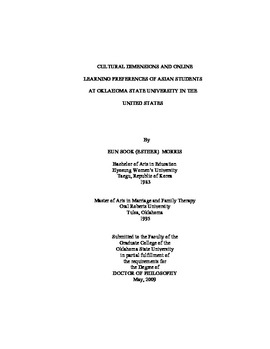| dc.contributor.advisor | Ausburn, Lynna | |
| dc.contributor.author | Morris, Eun Sook (Esther) | |
| dc.date.accessioned | 2013-11-26T08:34:45Z | |
| dc.date.available | 2013-11-26T08:34:45Z | |
| dc.date.issued | 2009-05 | |
| dc.identifier.uri | https://hdl.handle.net/11244/7511 | |
| dc.description.abstract | Scope and Method of Study: The purpose of this study was identifying Asian students' online learning preferences, personal problems, online learning benefits, and personal recommendations for improvement of online learning. The population of this study was the students who came from East Asia countries such as Korea, Japan, China, and Taiwan. This research used an online survey questionnaire. To quantify the demographic profile, forced-choice questions were used. To identify online learning preferences, a five-point Likert type rating scale was used. To discover online learning personal problems, benefits, and recommendations for improvements, open-ended questions were used. Descriptive statistics and thematic analysis were used to analyze the collected data. Asian students' online learning preference were measured in accordance with Henderson's multiple cultural model. A new survey instrument was developed. Correlation coefficient analysis and exploratory factor analysis were used to establish validity and reliability of the instrument. A pilot study also conducted. | |
| dc.description.abstract | Findings and Conclusions: Among 82 respondents, 34 students had online learning experiences. The results indicate that Asian students prefer behavioral learning theory-based instruction, learning that is sharply focused on learning objectives, that is rigid with hierarchical instruction. Also they prefer direct instruction, extrinsic motivation, instructor-proof instruction, strictly controlled learning, and cooperative learning. These learning preferences are related to the Asian culture. Preference of behavioral learning theory-based instruction is related to rigid entrance examination procedures common in most Asian countries. These findings are used to generate a set of recommendations for instructors of Asian students in online learning environments in the United States. The basic recommendations are that instructors should be aware of the learning preferences of Asian students who tend to work well in instructor controlled learning environments with sharply focused learning objectives. Also, instructors should be aware of Asian students culturally-based problems in online learning situations, principally communications problems stemming from unfamiliarity with non-standard English and Western cultural characteristics. | |
| dc.format | application/pdf | |
| dc.language | en_US | |
| dc.rights | Copyright is held by the author who has granted the Oklahoma State University Library the non-exclusive right to share this material in its institutional repository. Contact Digital Library Services at lib-dls@okstate.edu or 405-744-9161 for the permission policy on the use, reproduction or distribution of this material. | |
| dc.title | Cultural dimensions and online learning preferences of Asian students at Oklahoma State University in the United States | |
| dc.contributor.committeeMember | Self, Mary Jo | |
| dc.contributor.committeeMember | McCharen, Belinda | |
| dc.contributor.committeeMember | Conti, Gary | |
| osu.filename | Morris_okstate_0664D_10262.pdf | |
| osu.accesstype | Open Access | |
| dc.type.genre | Dissertation | |
| dc.type.material | Text | |
| dc.subject.keywords | asian students | |
| dc.subject.keywords | cultural dimensions | |
| dc.subject.keywords | learning preferences | |
| dc.subject.keywords | online learning | |
| thesis.degree.discipline | Education | |
| thesis.degree.grantor | Oklahoma State University | |
